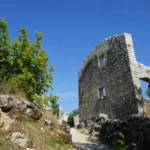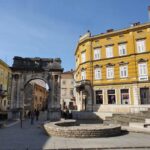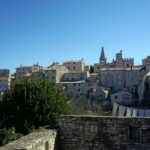Located in southwest Istria about 10 kilometres north of Pula, the largest city of the peninsula, Vodnjan is colourful and full of topics.
Why should you visit Vodnjan
Unlike other old Istrian towns that were mostly built on hills, Vodnjan—like the neighbouring Svetvinčenat—was built on a plateau with rare, shallow karst depressions called “vale” (hollows). At first glance, it may not seem as remarkable as the hilltop towns of central Istria, yet Vodnjan hides many medieval treasures worthy of superlatives. Its parish church of St. Blaise is considered the largest in Istria, and its bell tower the highest. At the same time, Market Street (Trgovačka) is thought to be the longest in any Istrian town.
The town itself is magnificent. Its surroundings boast the highest concentration of Kažun—dry-stone houses typical of the Mediterranean—and the area is renowned for its excellent olive oil. Vodnjan has one of the oldest olive oil traditions on the peninsula, and tasting it is a must. What I recommend when visiting Vodnjan is to search for its hidden traces of history. Many of them are not immediately visible, yet if you look closely—as we did—you can uncover them all. In the ebook we prepared, you will find the full story of Vodnjan. This cultural, historical, and heritage-rich town offers a variety of stunning experiences.
Even today, Vodnjan has preserved the appearance of a compact medieval settlement: a central square and main longitudinal street, intersected by narrow cross streets, lined with representative Gothic, Renaissance, and Baroque palaces, picturesque vaults, courts, and other forms of typical Mediterranean architecture.
Vodnjan in history
Though today considered part of southern Istria, Vodnjan has always stood at a crossroads—geographically and culturally—between west and east. Just ten kilometres north of Pula and 135 metres above sea level, it sits at the intersection of ancient and modern roads. Drive from Fažana on the west to Rakalj on the east, and you will likely pass by Vodnjan. Its strategic position has shaped its story for centuries.
Vodnjan began as a small settlement on the site of an original Illyrian and later Roman community. The first written mention dates back to 1150. You might be surprised to learn that until fairly recently, Vodnjan was one of the most prominent towns in Istria—larger than Pula for much of the 16th century. Its population grew to around 1,500 inhabitants at a time when Pula was nearly deserted due to epidemics and misfortunes.
The town’s fortune began to shift when the Austro-Hungarian Empire invested heavily in Pula, turning it into the region’s largest military port. Interestingly, the bishops of Pula often sought refuge in Vodnjan, which may explain why the town largely escaped devastating epidemics. Venetian officials and travel writers of the time frequently praised Vodnjan as a “flourishing city.”
The heart of the town likely formed on the foundations of a prehistoric hillfort. At a crucial border junction, it evolved into a community of exiled Roman legionaries who took up agriculture. After the fall of the Western Roman Empire, the Ostrogoths and Byzantines ruled the region, during which Vodnjan and its surroundings saw economic and cultural growth, including the construction of numerous castles and churches.
In 751, Lombards destroyed Vodnjan along with many other settlements across feudal Istria. By the 12th century, it was referred to as Antoninianus. Over the next two centuries, the town appears as Adignano, first as a terra (estate), later as Castello (fortified town) and Torre (tower). In the 13th century, the fortified city of Attinianus—also called Attinianum—occupied the area of today’s town square and its surroundings. Its defensive walls featured three gates, and by 1338, the settlement was recorded as Turris Adignanum.
Research by Ivetac indicates that the name Adignano was first documented in 1194 during a court hearing. The Croatian form of the name appears in the 13th century, while in Italian it became Dignano, and in Croatian, Vodnjan, the name that has endured since the 14th century. So, step into Vodnjan, and you walk through layers of history: from Illyrians to Romans, from bishops seeking refuge to Venetian praise, from fortified walls to today’s charming medieval streets. Each corner, each plaza, tells a story waiting to be discovered.
Things to do in Vodnjan
There are a lot of historical in the city of olive oil. Be sure to walk the cobblestone streets of Vodnjan. Strolling from square to square, from volt to volt one will feel like stepping back in time…and you can learn a lot from its past while walking between of the monuments. There are just about fifteen churches in Vodnjan and its surroundings. Visit at least some of them we mentioned below. The oldest, the most famed St. Blase church is closer to the city centre.
Enjoy the colours of The Old Town and visit People’s Square (Narodni Trg)
You should do as soon as you stop in Vodnjan to walk its longest street leading till the “Narodni (People’s) Square” which is the town core, a place of public life in the city. The square filled by brightly-coloured homes is dominated by the imposing Bradamente Palace dating back from the 17th century. Thepalace that seems to be in origin built as Venetian loggia served over the centuries is an example of the city’s rich architectural heritage. However the loggia at a glance, the palace served as a warehouse for barley storage, the seat of the Podestà (chief magistrate of a city-state, mayor), an archive, a local health office, a guardhouse, the Cashier’s office, the Municipal Commissioner’s Residence, a prison and theatre, a Recruitment centre, the Imperial-Royal Commissariat, a District Court and a final as a residential building.
Looking at the various and opulence of architecture patterned here offers an excellent opportunity to enjoy the city artistic features. Take a break here on the “Narodni Square” and have some of your favourite drinks while you’re enjoying this historical feature.One will get motivated to become an artist right here while strolling this typical Mediterranean place’s colourful square.
See theNeo-Gothic Town Palace
The picturesque building having a red facade is another palace making a part of the “Narodni Square”. The Neo-Gothic building dating back from 1911 serves as a town palace. It is one of the most recognizable symbols of Vodnjan.
Look the St. Blase Church (Sveti Blaž)
The largest church not only in Vodnjan but also in the whole Istrian peninsula the parish Church of St. Blase (Sveti Blaž) is located on the square in the very centre of the town. The church dating back of 18th century was built on the older church’s remnants from the locals’ income. The present-day parish church once stood a basilica, most probably from the 11th century, pulled down in 1760.The new church was modelled after the Venetian church of San Pietro in Castello that was work by Italian architect Andrea Palladio. The project costs were about 13,000 gold coins.It’s noted the locals donated a tenth of their income and a tenth of their wine and olive oil for ten more years to build the church which construction lasted from 1760 to 1800.
You shouldn’t miss a look at the building’s facade that is decorated with five life-size statues. St. Blaise is in the middle, to the right of him St. Lovro and St. Peter, while St. Quirinus and St. Paul are painted on the left. Andrea and Giovanni, Veneri Trevisano, a weaver, upholsterer, self-taught musician and painter, carved the statues.
See the Vodnjan Mummies and Sacral Art collection
Over 730 exhibits dating from the period 400 and the 19th century are in the Sacral Art Collection. Containing the stone reliefs, fifteen paintings and sculptureson canvas and wood, some hundred precious reliquaries, numerous books, manuscripts, jewellery, vestments, etc., presenting a complete picture of the Middle Ages. All of it is housed in St. BlaseChurch we already mentioned.
Besides the St. Blasé church holds a valuable collection of sacral art in the last years has become famed by containing behind the altar the370 relics belonging to 250 different bodies of saints, the so-called “Vodnjan Mummies”. It is believed that the preserved bodies of the saints have healing powers. This is the reason a church is visited by around 15,000 people a year.
Take a photo of the bell tower
The most dominated building and the highest one in Vodnjan and Istria again is a 63-metre high bell-tower. It was added next to the church in the mid-19thcentury. Don’t miss to look prominent but at a glance of eye superb stone structure that shows the Venetian impact. Yes, it was modelledright to that one in Venice, the bell tower of St. Marcus.
Make a walk alongside Bettica palace
The thing you shouldn’t miss to visit while strolling the streets of Vodnjan is to take a photo of the magnificent Bettica Palace. The palace located in the old town was built in the 14th century in the Gothic-Renaissance style.
Look at the Church of the Holy Cross
Next to the bus stop at the beginning of “Istarska Street” is the Church of the Holy Cross dating back from 1468. It was the seat of the Brotherhood of Whippers (flagellants). This church once served as a shelter where Pula bishops use to overnight due to their visits to Vodnjan. There stood his horses, carriage, and servants.
Admire the tiny church of St. Jacobs (Jakov)
While you walk alongside the narrow alley that stretches to the right of the main street leading to the People’s Square (Narodni Trg), you’ll mention the tiny church of St. Jacobs (Jakov). The church dating back to the 9th century is considered the peace between Pula and Vodnjan. This is why both of the places were signed a council right in this church in 1393. In 1492, the people of Vodnjan passed the city statute in it.
Look for the art in “Apoteka”(Pharmacy)
Established in 2013 at an initiative by Matija Debeljuh (visual and film artist) and Branka Bencic (curator) this “Space for Contemporary Art” was founded in the old town Vodnjan (Istra, Croatia), in the premises of an abandoned pharmacy. It is a flexible concept that works in the space of “in-between” – different positions and ideas.
The place is living the culture and serves to be for several purposes: a gallery,an office, an active agent, focusing on presentation, exhibiting, research space, development, understanding, promotion, communication, networking in the field of contemporary artistic practices, emerging artists, curate, innovative and creative culture.
Stop by at the Church of Our Lady of Mount Carmel
The church is located in the very historic centre of the town, in the lower part of the oldest, longest and best-known streets in Vodnjan “Trgovačka Street”, right after turning into Contrada del asì (vinegar alley).
The church dating back to 1630 was built with a ground plan in the shape of a “Latin cross”. It is specific to have an impressive facade made of finely dressed stone and a rosette standing above the coat of podestà Francesco Barbaro’s arms. The church interior is unique withhaving wooden guilt altar (1651), St. Sebastian’s statue, painting of Our Lady of Mount Carmel and St. Simon Stock, stucco-coffered ceiling, painted wall ornaments, organ and choir gallery above the main entrance. Though it is tiny, a single bell-tower is dominated over the church and was built apart of it.
Visit rural estates and Taste olive oil
You can find the rural estatesnearby Vodnjan. The buildings which were often included the landowner’s or farmhand’s house has beenstill calling “Stancija” by locals as it once uses to call. A typical building in Istria today recognized as the agricultural tourism point was mostly built for agriculture production. Once was served to overnight or staying in it during the period while the cattle or sheep keeping. Besides offering the accommodation services, many of them provide a variety of traditional or standard menu food today.
Vodnjan events
Like the other central Istria places, Vodnjan has their events, but the most famed one is held in the august.
Bumbarska Fešta Feast
This most recognized event in Vodnjan and its surroundings “Bumbarska Fešta or La Festa Dei Bumbari” has been held every year in middle August. To feel, an example of an Istrian town Vodnjan in the traditional style would be a unique and unforgettable experience. In that time is Vodnjan filled by artist workshops and you’ll find the outdoor shops on the streets offering the olive oil, wines and the other traditional staff.
The most liveable is with no doubt the central square filled by traditional music, and it is probably the most recognizable symbol of the feast.
St. Blase feast (Sveti Blaž)
This sacerdotal pilgrimage is held on the St. Blase day (03rd February) and it’s time when Vodnjan celebrates the day of the patron of the saint.
Be active in vodnjan
Vodnjan is not just as attractive as itself. Since its surroundings are natural, with arable fields, pastures, and forests, one can still enjoy the last traces. Let’s pass by old buildings, Roman roads, cisterns, wells, Roman villas, oil presses, and churches. It all enables us to make active tourism, and Vodnjan is an excellent place for outdoor lovers.
Putokoza cycling local tip: Vodnjan – Rakalj
An excellent southwest Istria area is full of the trails bounded by green landscapesboasts more than 120 km of marked bike trails, the majority of them being in and around Barbariga. Starting in Vodnjan this trail leading over the combination of road and macadam is lush of inspiration and nature. The tour guiding over the tiny places of Prodol and Krnica to the final point of St Agnes Church in picturesque Rakalj is one of those you should try while in Vodnjan.
Putokoza local hiking local tip: Kažuni & suhozidi trail (pasture and dry walls trail)
You can make it over the numerous pathways that surround the place. This trail takes you through the Istrian countryside, passing traditional round stone buildings known locally as “Kažun” and the characteristic dry stone walls – “Suhozidi”, which once marked the borders of pastures. The route offers a wonderful way to experience the region’s green landscapes and learn about local traditions. The tour begins in Vodnjan, following the main road toward the roundabout. Turn left and continue along the road toward the railway station, then cross the main street. Shortly after, you’ll enter the scenic countryside, where you can admire several Kažun houses (pasture house) structures and the dry stone walls (suhozid) that once divided the pastures.
Continue toward Salvela, Mednjan, and Batvači. Just before the village of Batvači, look for signs for St. Fosca Church, as this is also an area where more Kažun houses can be seen. From there, follow the signs toward Peroj, from which it is easy to return to Vodnjan. For those feeling adventurous, you can extend the route to Fažana, a small coastal town mentioned in the excursion section below. The trail is suitable for both walking and biking. Total distance: 20 km.
Daily tours in Vodnjan surrounding
Due to its geological position between eastern of Istria and its west or south coast, Vodnjan is an excellent point to start every kind of sightseeing. Though maybe tiny at a glance it offers so many of various things you can do in it. Besides the green landscapes, it’s bounded by the other small places or tourist destinationssuch as Rovinj or Pula that are not far away. Here we prepared just a few of the ideas.
St. Fosca Church
One of the well-known churches in the Vodnjan surroundings is located next to the old Roman road at Batvači near Peroj. It is only about 10 minutes car drive from Vodnjan. The church built on the remnants of a pre-Roman church, dating back to the unknown period but having the frescos assumed to belong of 12th century is dedicated to “Fosca” (“brunette”), the Roman martyr. According to the story, Fosca lived in the 3rd century in a Roman family. Still, after her conversion to Christianity, she was decapitated with having only the 15. Honoured to her on that place was raised the church.
Today the church is famed to be a place of the recuperation and recovery point. Legend has it that bishop Tommasini recorded the first healing case in 1681. After it, numerous believers mentioned miracles and healings. It’s believed St. Fosca protects against headache, rheumatism and arthritis.
Fažana
The little coastal place situated on southwest Istria in the Antiquity, the summer residence of Roman patricians. They built numerous villas there today is the best known to be “Gate of Brijuni”.
Located on the other side of a 3-kilometre wide channel, Fažana is probably the point in Istria. You can overlook the Brijuni Islands during a walk on the magnificent coastal promenade. Besides incredible architecture and the square over which dominates St Cosmas and Damian’s church, Fažana is made for outdoor fans.
Krnica & Krnički Porat
Krnica is a small picturesque village at an altitude of 195 m on the eastern coast of Istria. Since Krnica is a very peaceful village and there are no traffic jams during the summer, it has become a trendy place for tourists seeking a peaceful holiday. It’s very close to the sea and perfect for biking, trekking swimming, diving or boat peddling. Today, about 300 habitants were founded 1520 by the refugees from Dalmatia and are dominated by the parish church of St Rok and bell tower located in the middle. The tiny place will rejoice with its typical traditional architecture. The village has a post office, a store, and a pizza restaurant.
If you’re in Krnica or some of the other villages around during the summer you shouldn’t miss visiting St. Roko (Rokova) feast. That is a cultural event organized once a year, on August 16 and usually attracts around 500 people. Southeast from Krnica down there is a port named “Krnički port”. The place dominated by fishing boats has been kept the protected Istrian area charm with very few houses and wonderful nature.
Pula
Located on the very south of Istria, Pula besides to be the biggest city of the peninsula it has become a synonym for the gladiators “arena”, the imposing 1st century Roman Amphitheatre. If you’re architecture or history involved, you should visit Pula full of Roman heritage such as Augustus’s temple located in the Forum, several town gates, and the remains of theatre also fromRoman times. All of it you can in Pula that is only 15 minutes distant from Vodnjan.
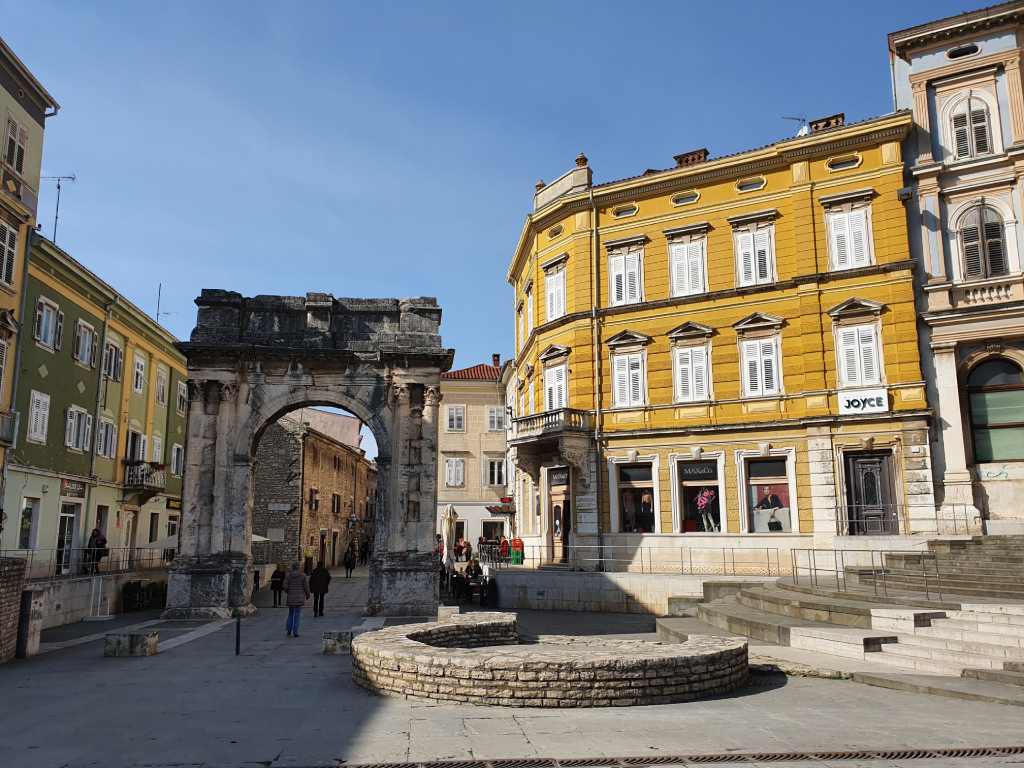
Also, to be recognized as Roman place, Pula was once an Austrian-Hungarian Navy port today full of mystical fortresses, underground tunnels, army barracks, hospitals, officers, villas and a military cemetery. Pula is the town of culture since it is full of the galleries and museums and is bounded by wonderful coastal heritage with the beaches.
Rakalj (Stari Rakalj)
The place recognized by a Latin name “Arcellae” says “Old Rakalj” is a small 11th century built castle located on the eastern coast of Istria. This place is a lush of inspiration, peace, and heritage. The St. Agnes church dating back to 1495 built on a 93 meters high hill ensures a magnificent view of the sea.
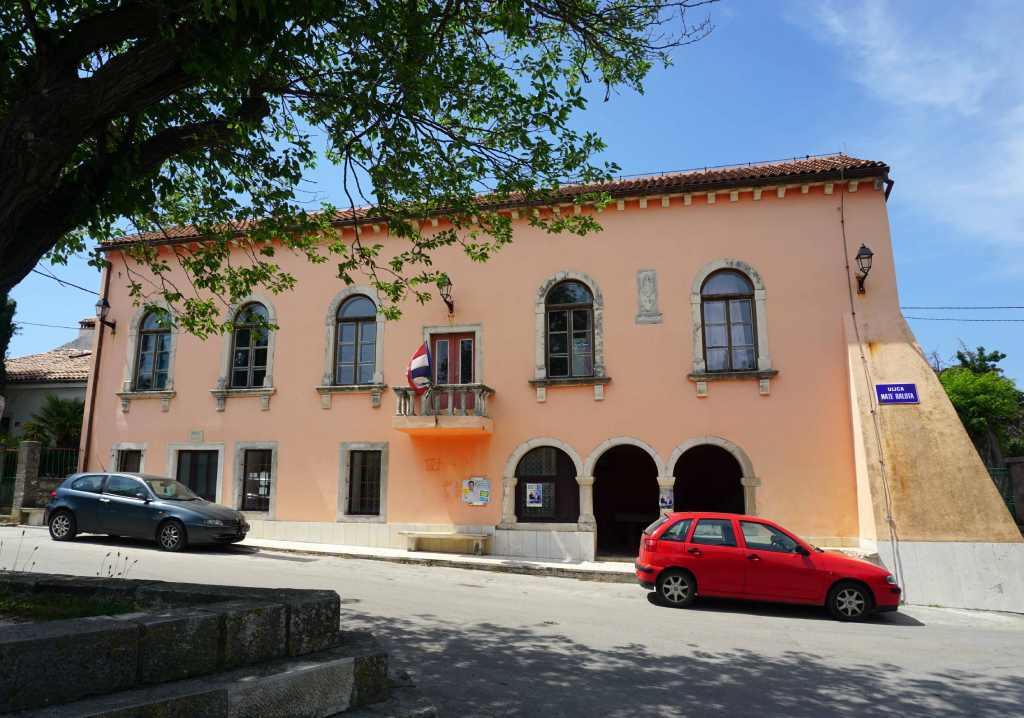
Though Rakalj seems tiny, it’s a born place of the famous Croatian writer and economist “Mijo Mirković – Mate Balota“. The monument honoured to him was raised on a small Rakalj cemetery where he was buried. After that, you visit the little place you can get down till the Adriatic Sea and taste the bright and clear eastern Istria water.
Bale
The medieval town will inspire you with its picturesque and colourfularchitecture built alongside the streets dominated by dialects spoken by the descendants of its Romanic inhabitants from south Istria.
The place that is most known by Sorado-Bembo castle is built as a living quarter between two towers. The parish church dating back of 1880 is also recognized by medieval architecture as the town loggia characterized by Venetian style, Pretorian manor, fortifications and gates. Bale has also been recognized as an outdoor destination and considered to be butterfly city. At the same time, the remains of dinosaurs have been found along the coast in its vicinity.
Putokoza local tip to Vodnjan
The particular thing you don’t want to miss while visiting Vodnjan is to stroll the cobblestone streets of the entire village around. Indeed, you’ll make beautiful photos of the place with the Meditteranean – Istrian charm.
But there is undoubtedly something more critical of it. The thing you shouldn’t miss is to taste excellent Istrian specialities such as prosciutto, cheese with the olive oil made from the olive grows, wine in surroundings. There are few of the rural households nearby and restaurants you can easily find.
Getting to Vodnjan
Since Vodnjan is set in a very central part of Istria, it could be reached from almost every aspect of the peninsula very easy by car. However, there are no public buses from Pula station operated through all the villages in the south of Istria, including Vodnjan.
- ✈️By Plane. Pula Airport (PUY), located in Valtura, is only 15 km from Vodnjan and the most convenient airport for visiting Istria. It offers domestic and international flights, especially during summer. From the airport, you can take the shuttle to Pula and then a public bus to Vodnjan. Bus line 23 connects the airport to Pula’s main bus station—check schedules in advance. Rent-a-car services and private transfers are also available, and pre-booking is recommended. Other nearby airports include Rijeka (RJK) and Trieste (TRS), both about 90 minutes from Vodnjan.
- 🚌 By Bus. Pula’s main bus station, about 20 km from Vodnjan, is well connected to major cities such as Zagreb, Rijeka, Venice, and Trieste. Local buses run regularly from Pula to Vodnjan, especially the line to Rovinj. Plan your arrival time carefully to coordinate with local departures. Taxis are available 24/7.
- 🚆 By Train. Vodnjan has a small local train station, but rail travel in Istria is limited. Daily connections exist to Pula and Buzet. Pula’s train station connects further to Zagreb, Ljubljana, and Maribor via bus/train transfers. The Pula–Buzet line is mainly used by locals and students.
- 🚗 By Car. Driving is one of the easiest ways to reach Vodnjan. The “Istrian Y” motorway connects all major towns in Istria with Slovenia and Italy. There are two exits for Vodnjan. From Trieste, the drive takes about 1.5 hours; from Zagreb, around 3–4 hours via the highway. After exiting, follow local roads to reach any destination across Istria. During summer months, expect heavy traffic and observe speed limits carefully.

